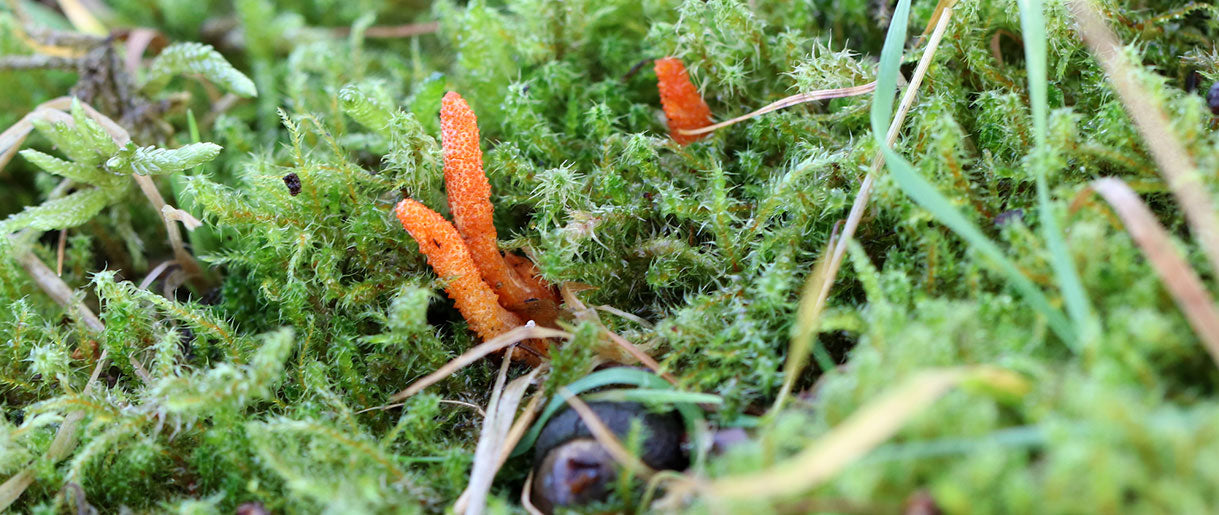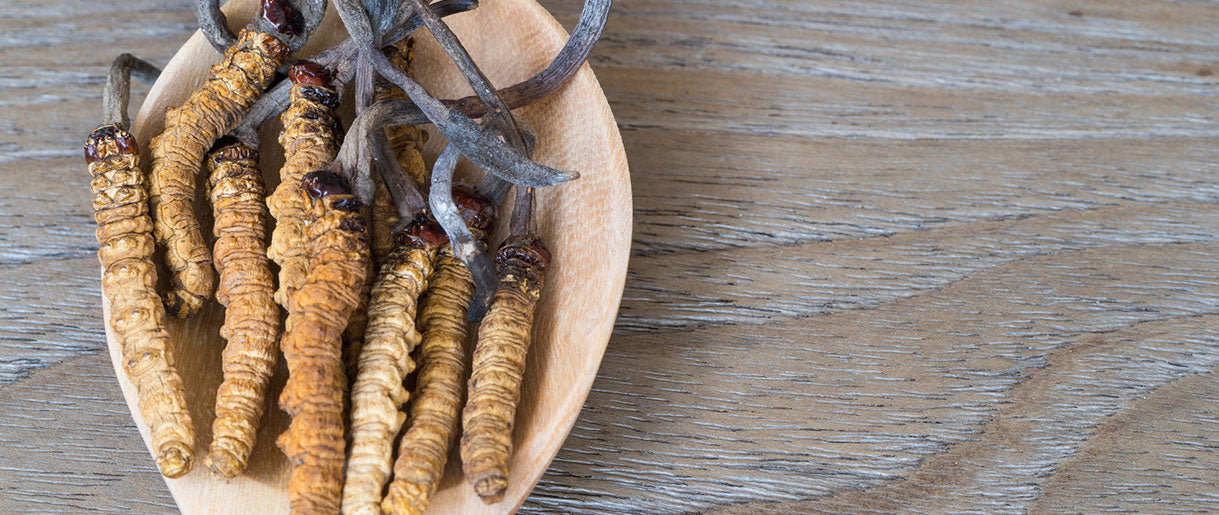Cordyceps Sinensis and Cordyceps Militaris are two varieties of the Cordyceps fungus known for their unique health benefits. Cordyceps Sinensis, primarily found in the high-altitude regions of China, Nepal, and Tibet, is recognized for its potential to enhance lung health, combat fatigue, and improve aerobic capacity.
Meanwhile, Cordyceps Militaris, more widely distributed globally, is revered for its potential anti-tumor, antioxidant, and immunomodulatory effects. It's also a more sustainable choice as it's easily cultivatable, unlike Sinensis, which relies on specific host insects for its growth. Both have valuable properties, but their choice often depends on personal health needs, sustainability concerns, and availability.
In this article, we will delve deeper into the world of these fascinating fungi, exploring their unique characteristics, health benefits, and the science behind their medicinal properties. As natural remedies continue to gain popularity in contemporary wellness culture, it's crucial to understand what these fungi are and how they differ, to make informed decisions about incorporating them into your health regimen.
Furthermore, we will also provide a comprehensive comparison between Cordyceps Sinensis and Cordyceps Militaris. By understanding their similarities, differences, and individual strengths, you can decide which one may be more suited to your needs. Whether you're already a fan of Cordyceps or just learning about them, this comparison will be a valuable guide in your journey toward holistic wellness.
Journey to the Rooftops of the World: Origins and Habitat of Cordyceps Sinensis

Cordyceps Sinensis, often referred to as the jewel among the Cordyceps species, holds a unique place among medicinal mushrooms. Native to the high-altitude regions of the Himalayas in China, Nepal, and Tibet, wild Cordyceps Sinensis thrives in these unique, harsh environments, making them truly extraordinary.
An Intricate Dance of Nature: The Growth and Life Cycle of Cordyceps Sinensis
The life cycle of the Cordyceps Sinensis fungus is a fascinating process that intertwines the lives of insects and fungi. The Cordyceps Sinensis species begins as a spore, infecting various insects.
Over time, the fungus takes over the host insect, eventually forming a mushroom fruiting body or a "fruit body" extending from the insect's carcass. This complex lifecycle is one reason for the rarity and high cost of wild Cordyceps Sinensis.
Ancient Wisdom for Modern Health: The Benefits and Traditional Uses of Cordyceps Sinensis
Cordyceps Sinensis has long been revered in traditional Chinese medicine for its multiple health benefits. Both Cordyceps Sinensis and other Cordyceps mushrooms are known to possess a rich array of bioactive compounds. These medicinal compounds, found in the fruiting body and mycelium, are believed to enhance athletic performance, support lung health, and provide anti-aging benefits.
Trust the Science: Studies Supporting the Benefits of Cordyceps Sinensis
The health benefits of Cordyceps Sinensis aren't just a matter of tradition. Modern scientific studies have started to unravel the potential of this medicinal mushroom. Research suggests(1) that the Cordyceps Sinensis fungus contains several bioactive compounds that may enhance immune function, increase stamina, and provide antioxidant effects.
Wild Cordyceps Sinensis, in particular, has attracted significant research attention. However, due to the rarity and difficulty in harvesting wild Cordyceps Sinensis, most studies use Cordyceps Sinensis cultivated in controlled conditions. Whether wild or cultivated, this remarkable medicinal mushroom astounds the scientific community with its potential health benefits.
Across Borders: Origins and Habitat of Cordyceps Militaris

Cordyceps Militaris, a distinguished member of the Cordyceps species, is not confined by the Himalayan boundaries like its counterpart, the Cordyceps Sinensis. Often called 'Himalayan Gold,' Cordyceps Militaris enjoys a wider distribution globally, making it a more accessible medicinal mushroom for researchers and consumers alike.
The Circle of Life: Growth and Life Cycle of Cordyceps Militaris
Like Cordyceps Sinensis, Cordyceps Militaris is a parasitic fungus exhibiting an unusual lifecycle. The "caterpillar fungus," as it is commonly known, infects the larvae of various insects, replacing the host tissue and eventually forming fruiting bodies above ground. Despite this eerie life cycle, precisely this parasitic process allows many of its healthful components to be created.
Echoes of the Past: Health Benefits and Traditional Uses of Cordyceps Militaris
Like Cordyceps Sinensis, Cordyceps Militaris has been recognized in traditional Chinese medicine for its health benefits. This Cordyceps mushroom contains several essential nutrients, including beta-glucans and essential amino acids. These nutrients and their unique bioactive compounds have been utilized in health practices to enhance immune functions, increase stamina, and support overall vitality.
Bridging Traditions and Science: Research Supporting the Benefits of Cordyceps Militaris
Modern research supports many of the traditional uses of the mushroom Cordyceps Militaris. Studies suggest that(2) the beta-glucans in Cordyceps Militaris can support immune health, while its rich content of essential amino acids contributes to overall wellness. Additionally, research is exploring Cordyceps Militaris' potential benefits in anti-aging, cognitive health, and even in combating certain types of cancer cells.
Uniting Distinct Paths: Similarities Between Cordyceps Sinensis and Militaris

In comparing Cordyceps Sinensis vs. Militaris, it's essential to recognize the common ground. Both Sinensis and Militaris are considered caterpillar fungi, as they share similar parasitic lifecycles.
They infect insect hosts, take over their bodies, and eventually sprout a fruiting body. This unique process gives both Cordyceps Militaris and Sinensis, also known as Ophiocordyceps Sinensis, unique characteristics and medicinal properties.
Celebrating Diversity: Differences in Composition and Health Benefits
We begin to appreciate their differences when we delve deeper into Cordyceps Militaris vs. Sinensis. Both these medicinal mushrooms contain a wealth of active compounds. However, while Sinensis is more associated with enhancing aerobic capacity and lung health, Militaris has been studied for its potential anti-tumor properties and rich beta-glucan content. This diversity in benefits reflects the wide-ranging health potential of these two species.
Sowing Seeds of Wellness: Differences in Cultivation and Availability
One of the critical points in the Cordyceps Sinensis vs. Militaris debate revolves around cultivation and availability. Sinensis, being native to the high-altitude regions of the Himalayas, is difficult to cultivate and collect, leading to limited availability and high cost. On the other hand, Militaris can be more easily cultivated in controlled conditions, making it a more sustainable and accessible choice among edible fungi.
The Wellness Champion: Which is More Beneficial?
In the Cordyceps Militaris vs. Sinensis debate, determining the more beneficial depends mainly on individual health needs and accessibility. While Sinensis has its unique benefits, the easy cultivation and availability of Militaris make it a more feasible choice for many.
The wealth of research around both Cordyceps Militaris and Sinensis continues to provide insights into their health benefits. Still, it's crucial to consult healthcare professionals to understand which suits individual health requirements best.
Bringing Cordyceps Home: How to Consume Cordyceps Mushrooms

The Elusive Counterpart: Incorporating Cordyceps Sinensis into Your Diet
When incorporating Cordyceps Sinensis into your diet, the most common method is through Cordyceps supplements. Given the rarity of the wild species and the difficulty in cultivating Cordyceps Sinensis, most people turn to Cordyceps Sinensis supplements for convenience and consistency.
These supplements can be found in various forms, including capsules, powders, and tinctures. Always ensure that you choose the best Cordyceps supplement from a reputable supplier for the best results.
Harnessing Himalayan Gold: Incorporating Cordyceps Militaris into Your Diet
Cordyceps Militaris, on the other hand, offers a broader range of dietary options due to its ease of cultivation. Like Sinensis, a Cordyceps supplement in the form of Militaris is also available. However, you can also find Cordyceps Militaris included in various Cordyceps products, such as mushroom teas, soups, and even as an ingredient in gourmet dishes.
Cautious Consumption: Possible Side Effects and Precautions When Using Cordyceps
While the health benefits of Cordyceps Sinensis and Militaris are impressive, it's essential also to be aware of the potential side effects of mushroom supplements. While the dangers of cordyceps are rare, some people may experience mild digestive discomfort, dry mouth, or nausea when first incorporating Cordyceps supplements into their diet.
More importantly, because Cordyceps can potentially affect blood sugar levels, individuals with diabetes or those preparing for surgery should consult a healthcare provider before incorporating Cordyceps into their dietary regimen.
Cordyceps Sinensis Vs Militaris Video
FAQs About Cordyceps Sinensis vs. Militaris
Can Cordyceps Sinensis And Cordyceps Militaris Be Taken Together?
While both Cordyceps Sinensis and Cordyceps Militaris offer unique health benefits, there's no scientific consensus on the implications of taking them together. Both varieties contain different bioactive components and may offer slightly different health benefits.
It's generally safe to consume both types, assuming no underlying health concern or medication may interact adversely with these supplements. But given the limited research on the combined use of these two species, it's advisable to consult a healthcare provider or a naturopathic physician before doing so.
Are There Specific Times Of The Day When It's Best To Take Cordyceps Supplements?
While there isn't a universally accepted best time to take Cordyceps supplements, some research, and anecdotal evidence suggest that taking them in the morning or early afternoon may be most beneficial. Cordyceps can enhance energy levels and may interfere with sleep if taken too late in the day.
However, how and when you should take Cordyceps can also depend on the reason for its use. For instance, if you're using Cordyceps pre-workout or to improve athletic performance, you might want to take it around an hour before your workout.
Can Cordyceps Sinensis Or Cordyceps Militaris Interact With Other Medications Or Supplements?
Like any supplement, Cordyceps Sinensis and Cordyceps Militaris can interact with certain medications and other supplements.
For instance, because Cordyceps can potentially lower blood sugar levels, it may interact with diabetes medications, potentially causing hypoglycemia or excessively low blood sugar levels.
Cordyceps may also have mild blood-thinning properties, so it might interact with anticoagulants or antiplatelet drugs, increasing the risk of bleeding.
Moreover, Cordyceps may affect the immune system, so it could interfere with medications that suppress the immune system or are intended to modulate an immune response.
Before starting any new supplement, it's essential to discuss it with a healthcare provider, especially if you have any pre-existing conditions or are taking any medications. Your healthcare provider can help you understand potential interactions and determine the appropriate dosage for your needs.
How Long Does It Take To See The Health Benefits After Using Cordyceps Sinensis Or Cordyceps Militaris?
The time it takes to see health benefits from using Cordyceps Sinensis or Cordyceps Militaris can vary depending on several factors, including individual response, dosage, and the specific health condition being addressed.
In some cases, people may notice improvements in their overall well-being and energy levels within a few days to a week of incorporating Cordyceps supplements into their daily routine. Others may experience more significant benefits over several weeks to a few months of consistent use.
Observing noticeable effects for certain specific health concerns, such as immune support or athletic performance enhancement, may take a bit longer. In such cases, the benefits may become more apparent with continued use over several weeks or months.
It's essential to remember that natural supplements like Cordyceps may not produce immediate or dramatic results for everyone. Individual responses can vary; some may require more time to experience the desired health benefits.
Key Takeaways
Throughout this exploration of Cordyceps Sinensis vs. Militaris, we have unveiled these two remarkable fungi's unique characteristics and health benefits. Cordyceps Sinensis, the elusive "caterpillar fungus" native to the Himalayan peaks, is treasured for its potential to enhance lung health and aerobic capacity. On the other hand, Cordyceps Militaris, more widely distributed and cultivated, offers potential anti-tumor properties and rich beta-glucans. While both species are celebrated as medicinal mushrooms, their distinct compositions and cultivation methods set them apart, making them suitable for various health needs.
When choosing between Cordyceps Sinensis and Militaris, it's crucial to consider individual health goals and accessibility. For those seeking the unique benefits of Sinensis and have access to authentic sources, it can be a valuable addition to support lung health and enhance athletic performance.
However, for a more readily available and sustainable option, Cordyceps Militaris is a worthy alternative, providing various health benefits and easy integration into daily diets. Ultimately, the decision depends on personal preferences and health objectives.
We'd love to hear your thoughts and experiences with Cordyceps! If you have any questions, insights, or personal stories related to Cordyceps Sinensis or Militaris, please share them in the comments below. Let's continue the conversation and build a community of knowledge and exploration around these exceptional medicinal mushrooms.
References
- Pharmacological and therapeutic potential ofCordyceps with special reference to Cordycepin, (1)https://www.ncbi.nlm.nih.gov/pmc/articles/PMC3909570/
- Trends in the Immunomodulatory Effects of Cordyceps militaris: Total Extracts, Polysaccharides and Cordycepin, (2)https://www.ncbi.nlm.nih.gov/pmc/articles/PMC7735063/










Let Us Know Your Comments